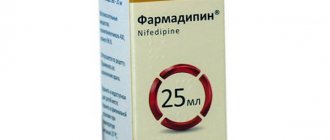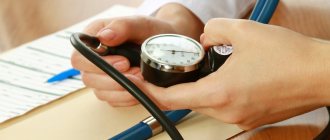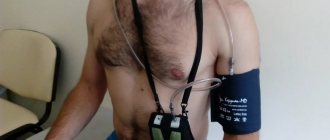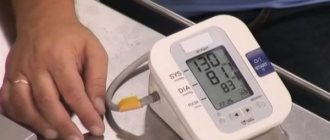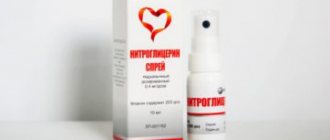Blood pressure monitoring is very important. Today, measurements with a tonometer can be carried out at home, regularly, without being subjected to mental or physical influence, as happens in a doctor's office. Preventive determination helps to identify the gradual or rapid development of hypertension (BP increases) in a person, which can lead to a heart attack or stroke. Regular monitoring can prevent health complications that might otherwise be missed. For proper monitoring, it is important to know what the numbers on the tonometer mean.
What do the tonometer readings mean?
In order to know what the numbers on the tonometer show, it is important to be able to correctly decipher the readings.
Below is the definition and classification of blood pressure in accordance with the WHO scale (data in mmHg):
| Category | Systole | Diastole | |
| Optimal | And | ||
| Normal | 120–129 | and/or | 80–84 |
| Increased | 130–139 | and/or | 85–89 |
| Stage 1 hypertension | 140–159 | and/or | 90–99 |
| Stage 2 hypertension | 160–179 | and/or | 100–109 |
| 3. stage of hypertension | ≥ 180 | and/or | ≥ 110 |
| Isolated systolic hypertension | ≥ 140 | And |
SYS and DIA numbers
Blood pressure is the force exerted by the blood on the wall of the arteries. It is demonstrated by two numbers - the tonometer shows them as SYS and DIA. The heart works like a pump, pumping blood into the bloodstream, and cycles (repeatedly) through resting and working phases.
What do the numbers mean when measuring blood pressure:
- the first number (upper) indicates systolic pressure; measured by heart contraction, the release of blood into the arteries;
- the second digit when measuring pressure displays diastolic pressure; determined at the moment of the resting phase between two contractions.
The numbers SYS and DIA - upper and lower pressure - mean the current blood pressure value; when recording, they are separated by a slash (for example, 120/80).
Algorithm for taking measurements depending on the type of tonometer
There are several types of digital blood pressure monitors. The following are distinguished:
- Automatic.
- Semi-automatic.
- Carpals.
Table No. 1. Features of different types of electronic tonometers.
| Tonometer type | Peculiarities | Note |
| The automatic type of electronic tonometer does not require the participation of the patient or other persons. With such a device you can easily measure your own blood pressure. To carry out the procedure for measuring blood pressure, you just need to put on the cuff correctly and press the button that activates the device. | Can be used by any category of patients. |
| This type of device requires patient participation. Equipped with a rubber bulb that helps fill the cuff with air. | Can be used by any category of patients. |
| As a rule, they are fully automatic. The cuffs of such devices are placed on the wrist, and the readings are recorded on the thin radial artery. | It is not recommended for use by persons diagnosed with the cardiovascular system, as well as by patients over 45 years of age. |
Each type of tonometer is equipped with highly sensitive sensors that respond to air fluctuations in the cuff. And air vibrations, in turn, reflect the frequency and strength of blood impulses in the arteries.
Note that the wrist devices, as we have already indicated, reflect the pressure on the thinner radial artery, so the indicators of such measurements cannot always be considered reliable; they have some error. There are some limitations to their use, as outlined in the table above.
Auto
Measuring blood pressure with an automatic tonometer will be easy even for old people. They are suitable for lonely elderly people suffering from characteristic diseases that require regular monitoring of blood pressure. Such procedures do not require outside help; anyone can handle them.
The algorithm for taking measurements with an automatic device is as follows:
- Sit comfortably on a chair, leaning on the back. The body should not be in any tension.
- Before starting the procedure, you should sit quietly for 5-10 minutes. Take several deep breaths and exhalations.
- Place your hand on a table or any other flat surface so that it is at chest level.
- Put on the cuff; the tubes of the device should be on the inside of the limb.
- Secure the cuff, making sure that it is not too loose or too tight around the arm. A cuff is properly worn when you can fit a finger between it and your arm.
- Turn on the device. This will be the “start” or “start” button.
- After turning on the device, the cuff will automatically fill with air and then deflate.
- After completion, the results of the upper and lower blood pressure, including heart rate indicators, will appear on the screen.
During the period of pressure measurements, the hand should be in a relaxed state.
Semi-automatic
The operating principle of a semi-automatic device is identical to that of an automatic device. The differences are that when using a semi-automatic one, the patient or his assistant needs to pump air into the cuff themselves; this is done using a rubber bulb. To release air, press a special button. The values will also be displayed on the device monitor.
Carpal
Wrist types are easy to use, they are compact, this allows you to take the device with you on any trip. The measurement algorithm is similar to the automatic one, with the exception of some nuances, the main one being the application of a cuff to the forearm.
To measure blood pressure using a wrist tonometer, you must adhere to the following recommendations:
- Remove all jewelry (bracelets, watches, rings, etc.) from the hand and wrist.
- The position of the hand should be at chest level, with the thumb facing up.
- The cuff is worn over bare skin. The cuff is correctly placed when it is located 1.5 cm above the fold of the wrist.
- The device display should face up.
- With your other hand, press the start button and wait for the device to pump air into the cuff and then deflate it. After this, blood pressure and heart rate indicators will be displayed on the screen.
Attention. When using a wrist tonometer, do not move your hand or fingers.
When measuring pressure, the hand should be at the level of the heart.
If you compare the indicators of the automatic and wrist tonometer, you can see minor deviations. This fact is considered the norm. To ensure the reliability of the result, it is recommended to repeat the procedure several times after 2-3 minutes and compare the data obtained.
Heart rate
The heart of an adult and a child’s heart beats rhythmically and regularly (in an adult, usually 70–80 times per minute at rest). These contractions are called the heartbeat.
Modern blood pressure monitors have a heartbeat icon - the third number. Detection of an irregular heart rhythm signals an arrhythmia. The appearance of a symbol (heart) on the display means that a heart rhythm disturbance was detected when determining blood pressure. In this case, the meaning of the numbers when measuring blood pressure may be erroneous; the procedure should be repeated.
Generally there is no reason to be concerned. But if the indicator symbol appears regularly (with daily monitoring several times a week), it is recommended to consult a doctor.
Important! The device does not replace a medical examination, but serves to detect irregular heart rhythms and blood pressure disorders at an early stage.
How to choose an automatic blood pressure monitor for home use?
Today there are many models and brands, and the choice is quite difficult. An inexperienced person may think that it is easy to choose the best blood pressure monitor: buy the latest model of a famous brand, but it should be noted that each option has various advantages and disadvantages, and special attention should be paid to the issue of choice.
The first thing a person pays attention to is the price. And rightly so - the price will be the first indicator of not only the quality, but also the functionality of each model. Before purchasing, you can first study all the advantages of cheaper models and determine how relevant it will be to purchase budget options. First of all, in addition to the price, you need to pay attention to the following parameters:
- When choosing an automatic non-contact ophthalmic tonometer, an important factor that needs to be taken into account is the presence of Russian-language instructions so that a person can easily learn how to use the device and understand the principle of its operation. Considering that such equipment is usually purchased for older people, this is a very important parameter, since older people have difficulty adapting to modern technologies.
- Another important parameter will be the build quality. All parts of the device must hold firmly enough and must fit perfectly together. The battery compartment in an automatic device is an important element, and it should close tightly enough, but at the same time be easy to open if necessary.
- Additional features are the most difficult issue. This additional feature could be a digital clock and calendar, or even smart analyzers that allow you to avoid excessive squeezing of your hand while working. Here it is worth first considering whether the patient needs these functions or not, because if additional functions are simply not needed, then you can choose a cheaper automatic tonometer.
To check which automatic blood pressure monitor is better, you need to carefully study the presented models of different brands. The Japanese tonometers Microlife, Reichert 7 and Omron have proven themselves most well in this regard in Russia, but these manufacturers also supply the most expensive models. Of the cheaper options, models from the American manufacturer AND have good technical characteristics - they are much cheaper than Omron and Microlife, but at the same time they have high quality, and the price reduction is achieved by eliminating expensive unnecessary additional functions.
Graphic blood pressure level indicator
24-hour blood pressure monitoring has been recognized as the gold standard in the diagnosis and treatment management of hypertension over the past few years as it provides an overview of absolute values and blood pressure variability over a period of time. Compared to random measurements, daily monitoring has a number of advantages:
- greater accuracy;
- reliability;
- reproducibility;
- automation;
- closer correlation with changes in organs.
Today, fully automated tonometers equipped with a number of technical amenities are used to measure blood pressure. They work on the principle of oscillometry and auscultation using the classical Korotkoff method. The patient wears a tonometer located in a sheath on the torso; the cuff with the measuring probe is located above the brachialis muscle. The measurement frequency is user-defined; recordings in the waking state vary between 15–30 min; in sleep, the intervals are longer (30–60 min). Individual measurements are stored in memory and can be reproduced in the evaluation unit or processed by a computer. On a computer, the display and interpretation of indicators is presented both digitally and graphically in the form of histograms, systolic, diastolic, average values, and heart rate curves. An analysis of maximum, minimum, and average values is also carried out.
The patient keeps temporary records of subjective problems and treatment, which are compared with pressure readings.
How to measure blood pressure correctly?
To determine the pressure correctly, it is necessary to follow a clear measurement algorithm. If you follow these instructions step by step, you will be able to get the most plausible result. But the resulting measurement must be analyzed in any case, since there may be some distorting factors.
The instructions look like this:
- Rest for 5-7 minutes. You should just sit or lie down quietly. Even if a person has not previously done any work or had no physical activity, this is necessary - ordinary walking or mental work can distort the indicators.
- Take a comfortable and correct position, from the point of view of the measurement algorithm.
- Put on the cuff.
- Take measurements.
- Record the received data in a special sheet.
- For more accurate indicators, check the results again after 10-15 minutes or measure blood pressure on your second arm to verify the data.
Only at first glance everything is simple here. But in fact, people do not always know all the nuances, which is why they receive incorrect results of blood pressure measurements, which significantly distorts the clinical picture.
For example, few people know that during the measurement process you cannot talk, or move even a little (move your finger). The body should be as relaxed as possible and breathing should be even. Otherwise, blood pressure may be elevated and understanding what causes this will be extremely problematic.
High pressure indicator
The blood pressure level indicator is located along the left side of the tonometer display. The indicators that the numbers on the tonometer mean correspond to ESH. After the measurement, a color indication appears:
- green – optimal blood pressure;
- yellow – increased;
- orange – too high;
- red – dangerously high.
This function allows you to quickly navigate and evaluate measurement results.
Smart Metering Technology
Intellisense is a unique intelligent blood pressure monitoring technology found in Omron blood pressure monitors. It offers a number of advantages:
- Accuracy. Intellisense takes 2 pressure measurements per cycle: one while the cuff is inflating, the other while deflating. Thanks to this dual monitoring method, the results are always accurate and reliable.
- Fast and pleasant measurement. Because Intellisense takes measurements while inflating, the cuff inflates just enough to accurately estimate BP. Measurement time is significantly reduced. The hands are not clenched for too long.
- Simple controls. Tonometers with Intellisense technology automatically select the optimal cuff inflation. One button is enough for control.
- Four cuff types. Only blood pressure monitors with Intellisense technology allow the use of pediatric CS, regular CM, large CL and universal CC cuffs.
- Resistance to arrhythmias. Blood pressure monitors with Intellisense technology are suitable for people with certain types of cardiac arrhythmias. The heart rate disturbance indicator is shown on the display.





